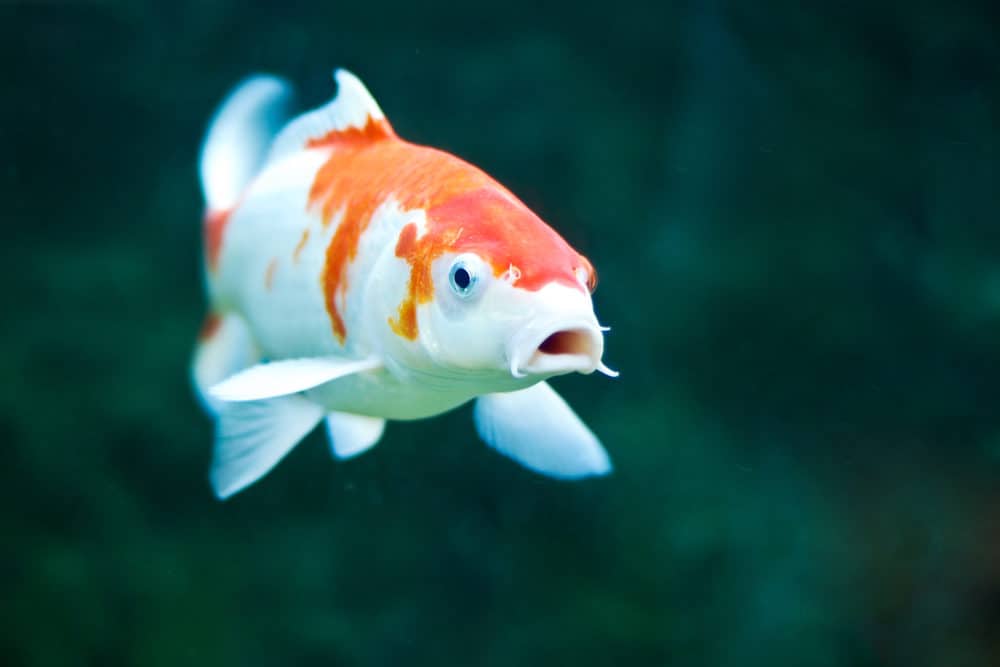Swim bladder disease is a common issue seen in a wide variety of fish, including ornamental varieties such as koi. Instead of referring to a specific illness, swim bladder disorder concerns various disorders relating to the swim bladder.
It is vital that any fish owner knows how to deal with swim bladder disease among the fish in their pond or aquarium.

Here, I will discuss everything that you need to know about swim bladder disease in Koi fish. I’m going to answer important questions that every koi pond owner should be asking, including:
Read on to see how you can keep your koi community happy, healthy, and free of potentially fatal swim bladder disease.
Most fish control their buoyancy using a unique organ known as a swim bladder, a gas bladder, an air bladder, or a fish maw. Under normal conditions, fish adjust the amount of gas stored in this bladder to float upwards or downwards at will.
Fish with swim bladder disease lose the ability to control their swim bladder, and thus, their movement. This lack of mobility can make it difficult for fish to swim, eat, and even breathe at late stages. Koi owners must keep a close eye on their fish to watch for signs of swim bladder disease.
The most apparent symptom of swim bladder disease is trouble controlling buoyancy. Koi fish that seem to have difficulty floating, sinking, or simply maintaining a normal position may have early-stage swim bladder disease.

Fish may also hang out in seemingly odd areas, such as floating towards the top or bottom of the tank. Often, they have trouble moving from their current position. In extreme cases, fish may begin to float upside down or on their sides.
You may notice other signs of swim bladder disease in koi fish, including a distended belly area and an arched back that place stress on the swim bladder area. Some koi fish with swim bladder disease also present changes in behavior. Often, fish will lose their appetite and stop eating normally. In some cases, fish lack the mobility they need to access food and feed normally.
You can often trace the roots of swim bladder disease back to digestive issues in koi fish. As physostomous fish, they control airflow to the swim bladder via a pneumatic tube in the mouth. When they feed on the surface, air can enter the swim bladder and lead to buoyancy disorders.
Other digestive issues can also cause swim bladder disease by distending the stomach, which places pressure on the bladder and makes it difficult to intake air. Eating too fast and overeating can lead to issues with their swim bladders, as can long-term constipation.

Low water temperature can also cause digestive upset that can lead to a swim bladder problem. Koi prefer temperatures of between 65 and 75℉ and may begin to experience digestive issues in colder environments.
Sometimes, it's not the stomach that presents an issue, but rather other organs around the swim bladder. Koi fish that suffer from fatty liver deposits, kidney cysts, or egg binding are all more at risk of developing a swim bladder issue. A bacterial infection or parasite can also cause inflammation in and around the swim bladder.
If you notice signs of swim bladder disease in your koi fish, the first thing you should do is to stop feeding them for three days straight. Once they're able to eat again, don't immediately return to their usual fish food. Switch to something soft and easy to digest for a few days, such as skinned peas, until you see improvement.
Adding aquarium salts to your water may also help to stave off swim bladder disease. Specially formulated salts add essential nutrients and electrolytes to the water, helping to improve overall fish health. Doing this can mitigate some of the symptoms of swim bladder disease due to stress.

If you think that your fish’s swim bladder condition is due to an infection or bacteria, you should quarantine the affected fish immediately. Otherwise, the disease can spread quickly through your pond and may end up killing off entire koi communities. Treat affected fish with a broad-spectrum antibiotic to eradicate the infection.
Poor water quality can make healthy fish more susceptible to a wide range of different health concerns, including swim bladder disease. One of the best ways to prevent outbreaks in your pond is by ensuring that you keep the water clean. Install filters, change the water regularly, and include a plant or two in your pond scape to encourage natural filtration.
Setting an appropriate feeding schedule can also work wonders towards preventing swim bladder disease. Try to avoid overfeeding your fish and only provide high-quality, easily digestible foods. Try soaking meals in water before feeding time to prevent air from entering the swim bladder while eating.
If you still notice your fish experiencing digestive issues on an adjusted feeding schedule, the water temperature could be to blame. You may need to add a heater to your pond to ensure that your koi community stays at a comfortable temperature, even during colder months.
Sometimes, fish can overcome common diseases on their own with a healthy immune system. Unfortunately, swim bladder issues rarely get better on their own without treatment. If you leave your koi fish untreated, you’re likely to see symptoms worsen. Eventually, the fish will die. It’s essential to keep an eye on your koi community and watch for signs of swim bladder disease so that you can address the issue as soon as possible.

Thankfully, swim bladder disease is treatable in fish if detected early enough. The crucial element to note here is how to prevent it from occurring in the first place and, if a fish does become afflicted, how to properly diagnose and treat the problem so there are no long-lasting health effects.



